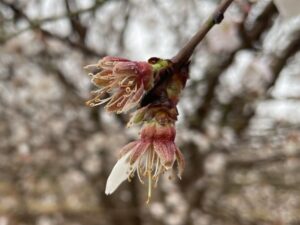
Petal fall through the first few weeks of nut development is a critical time for disease management. During this period, the almond fruit, newly emerged leaves, and senescing tissues are susceptible to many diseases. These include jacket rot, anthracnose, brown rot, leaf blight, shot-hole, scab, and with Mediterranean varieties, red blotch.
Protecting the developing fruits should be top priority through the early spring. Thorough disease control early in the season prevents the build-up of inoculum, reducing secondary spread of the disease. Typically, this is done with fungicides, which should be applied prior to rain events. Sprays should be made every 14-15 days if rainy conditions persist, but this period can be extended if dry conditions occur. If using broad spectrum fungicides such as Ziram, Captan, or copper, the re-application interval should be shortened to 10 days in rainy conditions.
The appropriate chemistry should be chosen to target the disease of concern. For example, triazole (FRAC 3) and strobilurin (FRAC 11) fungicides are not effective on botrytis jacket rot, but they do control other diseases well. Additionally, fungicide chemistries, not commercial brand names, should be rotated to reduce the formation of resistance. This is because multiple commercial brand names may use the same fungicide chemistry. This process has been streamlined through the use of a FRAC number. This number indicates the mode of action of the fungicide, and use of the same number in back-to-back applications should be avoided.
There has been increasing interest in biological products for control of diseases within almonds. Generally, these products work well in mild-to-moderate disease pressure years, control tends to be reduced in high pressure years(i.e. prolonged wet, rainy conditions). Some of these products can be tanked mixed with fungicides, but others cant. If the product is a live agent, such as a bacteria or fungi, they should not be mixed with fungicides or biocides. Extracts and peptides, however, can be tank mixed with fungicides without affecting the product efficacy. More can be found on page 38 of the efficacy studies conducted by the University of California (linked here).
Ideally, fungicides should be applied using a ground rig. This allows better deposition within the canopy of the tree, protecting the crop in the interior of the tree. Aerial applications, however, can be made if ground conditions are too wet for field access, and often perform reasonably well.
Spray solutions should be adjusted to improve efficacy. pH should be less than 7, with acidic solutions improving fungicide uptake. This becomes more important when additives are included such as foliar fertilizers and other types of products as they can change the solution’s pH. Alkaline solutions can also lead to precipitation of the spray mixture, and care must be taken to prevent rig damage.
It is tempting to reduce fungicide applications when commodity prices are variable. Don´t. A severe disease outbreak often takes multiple years to clean-up, costing much more than the preventative efforts. Additionally, it often leads to crop loss in both the current and future years. When it comes to disease management, an ounce of prevention is truly worth a pound of cure.

